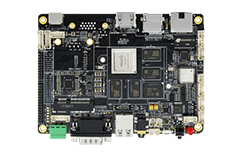1. ADC Use¶
1.1. Introduction¶
The AD interface on the AIO-3288C development board is divided into high-speed ADC stream interface, temperature sensor and successive approximation register. This paper mainly introduces the basic configuration methods of ADC.
An industrial I/O subsystem is used by the kernel to control the ADC, and the subsystem is primarily designed for the sensor of AD conversion or DA conversion.
Its associated data structures and configuration methods are as follows:
1.2. Data structure¶
1.2.1. iio_channel structure¶
struct iio_channel {
struct iio_dev *indio_dev;//industrial I/O device
const struct iio_chan_spec *channel;//I/O channel
void *data;
};
1.2.2. iio_dev structure¶
This structure is mainly used to describe the device to which the IO port belongs, and its specific definition is as follows:
struct iio_dev {
int id;
int modes;
int currentmode;
struct device dev;
struct iio_event_interface *event_interface;
struct iio_buffer *buffer;
struct list_head buffer_list;
int scan_bytes;
struct mutex mlock;
const unsigned long *available_scan_masks;
unsigned masklength;
const unsigned long *active_scan_mask;
bool scan_timestamp;
unsigned scan_index_timestamp;
struct iio_trigger *trig;
struct iio_poll_func *pollfunc;
struct iio_chan_spec const *channels;
int num_channels;
struct list_head channel_attr_list;
struct attribute_group chan_attr_group;
const char *name;
const struct iio_info *info;
struct mutex info_exist_lock;
const struct iio_buffer_setup_ops *setup_ops;
struct cdev chrdev;
#define IIO_MAX_GROUPS 6
const struct attribute_group *groups[IIO_MAX_GROUPS + 1];
int groupcounter;
unsigned long flags;
#if defined(CONFIG_DEBUG_FS)
struct dentry *debugfs_dentry;
unsigned cached_reg_addr;
#endif
};
1.2.3. iio_chan_spec structure¶
This structure is mainly used to describe the properties of a single channel, and its specific definition is as follows:
struct iio_chan_spec {
enum iio_chan_type type; // describe the channel type
int channel; //channel number
int channel2; //channel number
unsigned long address; //channel address
int scan_index;
struct {
char sign;
u8 realbits;
u8 storagebits;
u8 shift;
enum iio_endian endianness;
} scan_type;
long info_mask;
long info_mask_separate;
long info_mask_shared_by_type;
long event_mask;
const struct iio_chan_spec_ext_info *ext_info;
const char *extend_name;
const char *datasheet_name;
unsigned modified:1;
unsigned indexed:1;
unsigned output:1;
unsigned differential:1;
};
1.3. Configuration steps¶
1.3.1. Configure the DTS node¶
The DTS node for the Firefly ADC is defined in the kernel/arch/arm/boot/dts/rk3288.dtsi file, it is shown as follows:
adc: adc@ff100000 {
compatible = "rockchip,saradc";
reg = ;
interrupts = ;
#io-channel-cells = ;
io-channel-ranges;rockchip,adc-vref = ;
clock-frequency = ;
clocks = , ;
clock-names = "saradc", "pclk_saradc";
status = "disabled";
};
The user only needs to add the channel definition to the firefly-rk3288-aio-3288c.dts file and change its status to “okay”:
&adc {
status = "okay";
adc_test{
compatible = "rockchip,adc_test";
io-channels = ;
};
};
1.3.2. Match the DTS node in the driver file¶
Match the DTS node in the driver file:
static const struct of_device_id of_XXX_match[] = {
{ .compatible = "rockchip,adc_test" },
{ /* Sentinel */ }
};
Populate the structure array into the platform_driver that the ADC is used.
static struct platform_driver XXX_driver = {
.probe = ...,
.remove = ...,
.driver = {
.name = "..",
.owner = THIS_MODULE,
#ifdef CONFIG_OF
.of_match_table = of_XXX_match,
#endif
},
};
1.3.3. Get the AD Channel¶
struct iio_channel *chan; //define the IIO channel structure
chan = iio_channel_get(&pdev->dev, NULL); //get the IIO channel structure
Note: iio_channel_get gets the IIO channel structure through the parameter pdev passed in by the probe function, and the probe function is as follows:
static int XXX_probe(struct platform_device *pdev);
1.3.4. Read the raw data acquisited by AD¶
int val,ret;
ret = iio_read_channel_raw(chan, &val);
The iio_read_channel_raw function is called to read the raw data acquisited by AD and store it in val.
1.3.5. Calculate the voltage acquisited¶
The standard voltage is used to convert the value converted by AD to the desired voltage value for the user. It is calculated as follows:
Vref / (2^n-1) = Vresult / raw
Note:
Vref is the standard voltage
n is the number of bits converted by AD
Vresult is the acquisition voltage required by the user
raw is the raw data acquisited by the AD
For example, the standard voltage is 1.8V, the number of bits of AD acquisition is 10, and the raw data acquisited by AD is 568, then:
Vresult = (1800mv * 568) / 1023;
1.4. ADC common function interface¶
struct iio_channel *iio_channel_get(struct device *dev, const char *consumer_channel);
Function: get the iio channel description
Parameter:
dev: pointer to the device description using the channel
consumer_channel: pointer to IIO channel description used by the device
void iio_channel_release(struct iio_channel *chan);
Function: release the the channel acquired by the iio_channel_get function
Parameters:
chan:pointer to the channel description to be released
int iio_read_channel_raw(struct iio_channel *chan, int *val);
Function: read the raw data acquisited by chan channel AD.
Parameters:
chan:pointer to the acquisition channel to be read
val:pointer to store the reading results
